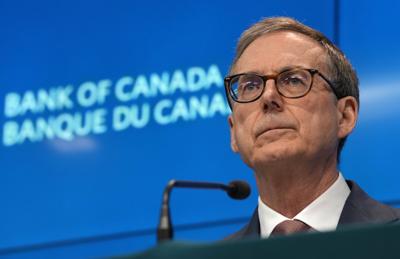The economic crystal ball is getting cloudier.
The Bank of Canada left its key overnight lending rate untouched at 2.75 per cent Wednesday, but bank governor Tiff Macklem said if the economy worsens amid U.S. President Donald Trump’sĚýunprecedentedĚýglobal trade war, it will consider cutting rates.
“It’s hard to be as forward-looking as usual when you have an unusual amount of uncertainty,” Macklem said in a press conference after the announcement. “We’re thinking about a range of scenarios. We’ve had to shorten our horizon.”
Macklem said one thing seems certain: Trump’s trade war means a smaller global economy and a smaller Canadian economy — even if a trade deal is reached with the U.S. ahead of Trump’s Aug. 1 deadline.
“The economy’s on a permanently lower path. Tariffs mean there’s going to be less income,” said Macklem. “Tariffs have a permanent effect on the economy, unless they’re removed.”
While there’s some evidence that tariffs have started pushing inflation upwards, Macklem suggested that the full impact has yet to be felt.
In a post on X, Ontario Premier Doug Ford blasted the bank’s decision, saying the economy needs the boost that lower rates would provide.
“I’m shocked by this decision. As we stare down economic uncertainty that’s putting hundreds of thousands of jobs at risk, it’s never been more important to stimulate economic growth and keep Canadians working,” Ford wrote. “Rather than wait around and let President Trump’s tariffs do even more damage to our economy, the Bank of Canada needs to cut interest rates now.”
BMO chief economist Douglas Porter said the bank is wisely hedging its bets on whether to cut rates.
“There’s simply too much lingering trade uncertainty for the BoC to be decisive on the outlook for now, hence the three scenario projections,” Porter wrote. “Further rate cuts will depend on ongoing economic softness and inflation pressures fading.”Ěý
Thus far, markets seem to agree with trading on the overnight interest swaps market pricing in just a 50 per cent chance of a rate cut by the end of the year, and just a 10 per cent chance of two cuts.
So far, Macklem says the Canadian economy has shown staying power, despite bank data showing that it likely contracted at an annualized rate of 1.5 per cent in the second quarter.
The bank’s monetary policy report — a look at the Canadian and global economiesĚý— predicted the Canadian economy will grow by 1.3 per cent this year, and limp to aĚý1.1 per cent growth rate in 2026, if the current tariff picture stays stable.
The report says 95 per cent of Canadian trade with the U.S. is compliant with the Canada-U.S.-Mexico agreement on trade.
If the U.S. backs down on some of its tariff threats, the Canadian economy would get an extra half percentage point boost. If the tariff situation were to escalate, the report sees the Canadian economy slumping into a recession.
The only economic certainty, the bank suggested, is more uncertainty.
“While some elements of U.S. trade policy have started to become more concrete in recent weeks, trade negotiations are fluid, threats of new sectoral tariffs continue, and U.S. trade actions remain unpredictable,” the bank said in its press release.
Economists are widely expecting the Bank of Canada to keep its benchmark interest rate on hold this week — though not all agree with that call. (July 28, 2025)
The Canadian PressThe bank has left its key rate alone now for three straight meetings, after cutting it seven times in a row from its five per cent peak.ĚýThe overnight rate has been at 2.75 per cent since March 12.
The bank began cutting last June amid concern over a faltering Canadian economy sparked by Trump’s tariffs.
The theory is that by making it cheaper to borrow money, consumers and businesses will spend more, boosting the economy but also potentially pushing prices upwards.





























To join the conversation set a first and last name in your user profile.
Sign in or register for free to join the Conversation